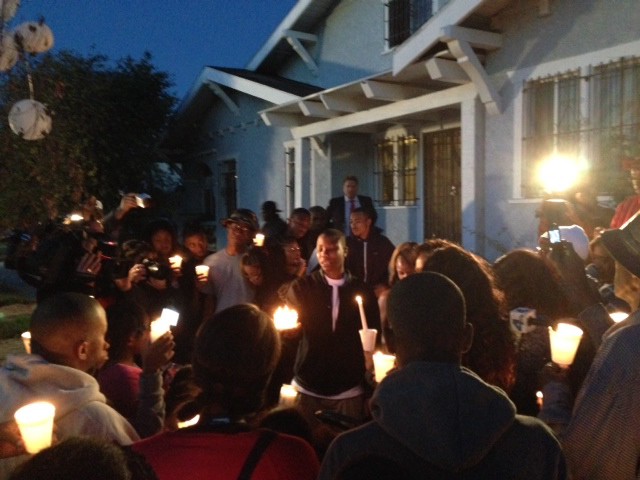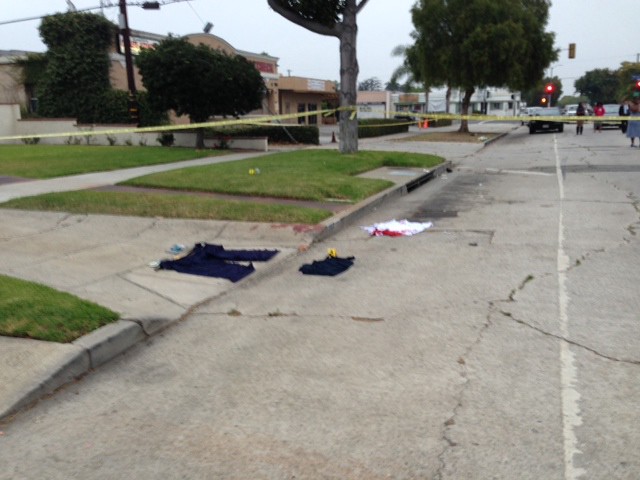Murder In Los Angeles
by Natasha Vargas-Cooper

I have one spiritual ritual in my life: every morning I check the Los Angeles Times’ Homicide Report blog to learn who was killed in Los Angeles County while I slept.1
The Homicide Report addresses two questions every newspaper covering a major metropolis should answer: who was killed last night, and why? But most newspapers don’t do this because the logic of most newsrooms is that not all murders are sexy, grisly, or surprising enough to be written about. The Homicide Report operates on the inverse principal: Every murder gets a story because murder is inherently worthy of our attention.2
The Homicide report is anchored by a single reporter, Nicole Santa Cruz, an Arizona-born Latina, with glasses, pretty Etsy jewelry and a sweet voice. Nicole makes a round of phone calls every morning to the coroner, the LAPD, and sheriff’s department to find out who died last night. In the weeks and months that follow she attempts to answer the question ‘why?’ She’s been on the job for a little under a year.

So far there have been 580 people killed in LA County within the last 12 months. For a county of 10 million residents, that number is low; it’s the lowest it’s been since the 1950’s. Our police chief and mayor pride themselves on the declining number and it’s become a routine talking point. The county reached it’s high of 1,011 in 1980, thanks to the spasmodic waves of violence that erupted from the crack epidemic.
While homicide is down county-wide, there are still pockets in Los Angeles, particularly in poor black and Latino communities, where the body count steadily rises every year. “For most people and communities in LA, murder is anomaly,” Nicole told me, “but there are still neighborhoods where murder is a weekly, even daily occurrence.”
One of those neighborhoods is Westmont, an unincorporated two-mile residential area right off the 105 freeway in South LA. Since 2007, 61 people have been killed in Westmont. Most of the murders have taken place along a two-block stretch of Vermont Ave., dubbed by residents and detectives as “Death Alley.” Westmont is populated by cheap rental apartments, liquor stores, junk shops, and churches and it has the highest homicide rate in the county. “Nearly every street in the area is claimed by gangs,” Nicole wrote earlier this year: “[the] Underground Crips, South Los, The Hoovers, 8 Trey Gangsters, the Raymond Crips and the Rollin’ 100s.” There is no city government in Westmont, which means there is no city police force or city council to institute any sort of violence prevention. But Westmont’s high crime rate, gang scourge, and lack of city services is exactly why it offers some of the cheapest rents in Los Angeles.


Nicole got her start on covering homicide writing about the Gabby Giffords shooting. But the first time Nicole reported on a fresh crime scene was at 3 a.m., in July of 2013. She took rapid notes as police and first responders ‘tagged and bagged’ the body of Ervin Cavitt, a 26-year-old black man, the son of a prominent gang interventionist. He was shot outside of a house party on Manchester Ave, after an argument with gang members.
Nicole relies on weekly spreadsheets from the coroner’s office to fill in any gaps law enforcement didn’t report over the phone. What appears on the coroner’s spreadsheet varies from boiler plate details — name, age, race, birthdate (this allows Nicole and her researcher to call the DMV and request a photo of the victim) — to a full narrative. It all depends on what the on-site police officer feels like writing down. “Most of the reports come back bare bones description, with just a GSW,” Nicole said. The acronym stands for gunshot wound; the most common cause of homicide in Los Angeles. “And sometimes it’s as detailed as ‘a man was sleeping near a door and another man wanted him to leave and there was an argument so the man was stabbed to death and the suspect is in custody.’” Nicole fills out the details of a victim’s life by knocking on doors of victim’s families. They often invite her in and show her photographs and tell as much of the story as they can.
When she can’t locate the family right away, Nicole will go to the slapdash roadside memorials and ask the people who bring the saint candles to burn along plastic flowers and stuffed teddy bears. There’s usually someone who wants to talk. Especially for the little ones. “The little kids, their lives are the hardest to write about, because there’s no life there, they didn’t get to live it,” she said.
There are three types of murders that most pique Nicole’s interest:
1. When there are murders in low-crime neighborhoods — most recently, the case of Harry Major, an 82-year-old retired high school teacher who was strangled to death inside of his Hollywood apartment.3
2. The deaths of very young people.
3. Women. According to the Homicide Report, men account for nearly 85% of homicides in Los Angeles County. Those men are between the ages of 17 to 25, and they are most often black or Latino. “When a woman gets killed, there is typically a really awful story that goes along with it,” she said.

When someone is killed they are assigned a series of numbers over several years time:
• A coroner’s report number.
• A police report number or a sheriff’s report number — depending on what part of town the body is discovered — if a suspect is arrested.
• A district attorney case number if they find the suspect and that person goes to trial.
None of these numbers are the same and there is no central database across agencies where you can type in someone’s name and see where and when they were killed, if the suspect who killed them was ever arrested, if that suspect went to trial, or the outcome of the trial. The Homicide report is trying, through journalism, to build that database. Nicole, a staff researcher, and a full-time member of the database team, Ken Schwencke (who rebuilt the Homicide Report in 2010 and gave it a much more user-friendly format, and who also built the paper’s earthquake story-writing robot) are going one year at a time, matching up murders with case numbers and outcomes. They are starting with 2009 because it takes about two years to go from a homicide arrest to a verdict.

The comment section of the Homicide Report is unlike any other discussion thread on the Internet. For one, they are categorically less racist than most of the LA Times’ other commenters. There also lengthy, fairly rational discussions about the chronic problems of broken homes, poverty, dysfunctional policing, and the overall nature of crime. Many commenters are members of the community with high murder rates and they come to Homicide Report to leave informal eulogies,
such as:
I was Anthony’s younger brother but no one in our family ever called him that. He was Tony to me, and little Tony to other family members (He shared my Dad’s name). To choose one memory would not do justice to his name since he brought so much joy to everyone. He would hide behind corners to try to scare me(And vice versa), feed me when I was hungry(Mostly hot cheetos, they were my favorite), but he also would comfort me. I remember years ago when my father was in the hospital Tony told me that Dad was most likely not going to make it. Was I sad? Of course. But till this day I always remember him being honest. He told me some of the most heart breaking news of my life then just got down on one knee and gave me a hug. He did so much for me and I never really told him thanks. I still remember playing video games with him prior to his death. I am writing this for unknown reasons. It is 6 in the morning and the only thing on my mind is what arm was his Van Halen tattoo on. He was shot because the shooters mistakenly saw a “VF” (Rival gang Varrio Flats)on his arm which was in fact a “VH”. They said they saw his tattoo and shot him but if it was on his left side, did they really see it? He always wore long sleeved shirts when he went out too. It was close to midnight as well, how could they really see his tattoo? Maybe I’m reading to much into this but I will always wonder. Tony, whether or not your soul is in Heaven(If it does exist) I hope you’re happy. Tell our Dad and Great Grandparents; Fred and Mary that I said, Hello. We all miss you, and Mom’s work gave you a spot on their golden tree of life thing. Anyway I love you man, and I will say to you what I said 6 years back “See you later foo.”
Other comments are paragraphs of deeply coded slang that Nicole and her co-workers try to decipher for clues about the murder. Nicole says she’s always struck “by comments where someone seems to be googling someone’s name and finds them on Homicide Report.”
“This one stood out because of the simplicity,” she said. It was for Carey Snyder, who was 63: “I think this was my father. May he finally be free.”
1. The people who commit murder, I don’t know what makes them do it. But I know the act of murder is evil. Considering it forces a cosmic bend in my mind. I was not raised with religion but murder is something that gives me the emotional and existential feeling of a dark force outside of human understanding.
2. In talking to Nicole about crime reporting, I found that we are the most fascinated by opposite sides of homicide: She with the victims and me with the perpetrators. She is compelled by grief of the victim’s family and I am obsessed with pathology of the assailants. We both believe there is some story to wrench out of these extreme modes of human behavior. During our lunch Nicole mentioned that she’d never known anyone who had been murdered. I know two people who have been killed. And I know two sets of families who have been pulverized by grief and I find it impossible to convey.
3. The Times reported last week that authorities arrested a New York parolee in connection to Major’s death. The parolee, Scott Kratlian, served a 20-year sentence for murder. The two met through a “General Hospital” fan club.
Natasha Vargas-Cooper is a reporter in Los Angeles. Photos by Nicole Santa Cruz.
